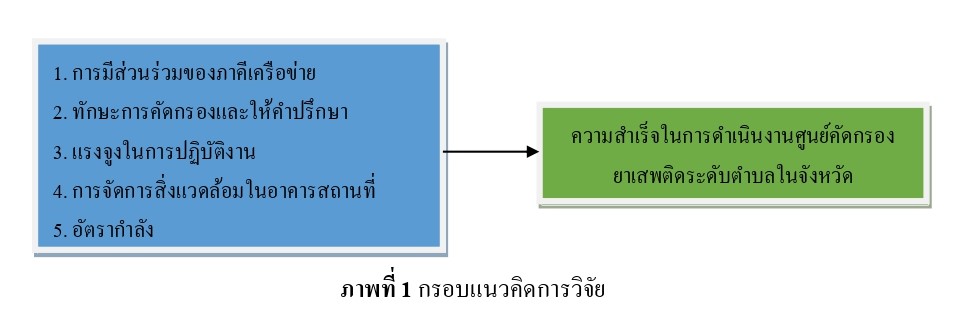Factors Predicting Success in Implementation of The Subdistrict Narcotic Dose Screening Center in Songkla Province
Keywords:
Subdistrict narcotic dose screening center, Success, Environmental management, MotivationAbstract
The purpose of this descriptive study was to investigate the factors influencing success in implementation of subdistrict narcotic dose screening center in Songkla province. 138 officers working in subdistrict narcotic dose screening center served as the samples with simple random sampling technique was used. The instruments used were questionnaires that demanded participation in a partnership network after the screening center committees' role, screening skills and officer consultation, work motivation, environmental and workplace management, workforce, and implementation success. The instruments' validity varied from.67 to 1.00. Alpha's Cronbach coefficient reliability indexes were 948,.954,.937,.967,.955, and.979, respectively.
Data were analyzed by using descriptive statistics and stepwise multiple regression analysis. According to the results overall of success in implementation of subdistrict narcotic dose screening center in Songkla province at a high level (M =3.71, S.D.= 0.78). Factors predicting success in implementation of subdistrict narcotic dose screening center in Songkla province were the workforce (Beta=.463), work motivation (Beta= .241), participation in partnership networks (Beta=.167), and environmental and workplace management (Beta=.133). These factors can explain 83.60% of the variance and had statistically significant at.001.
Therefore, the subdistrict narcotic dose screening center ought to enhance and get ready for environmental management, workforce management that is appropriate for the workload, empowerment in implementation through motivation, a focus on partnership network participation, and the availability of clear guidelines that are easier to follow with the registered nurse and officers working in subdistrict narcotic dose screening center.
References
Boonyamanee, B., & Nukaew, O. (2024). The Development and Effects of an Enhancing Empowerment Program on Self-regulation for Quitting Illegal Drugs among Patients with Amphetamine Addiction during Rehabilitation Phase. The Southern College Network Journal of Nursing and Public Health, 11(2), e267558. https://he01.tci-thaijo.org/index.php/ scnet/article/view/267558/181252
Chomsiri, K. (2017). The condition factors has an affecting with efficiency performance of certified public Accountants on Bangkok Area. [Master’s Thesis]. Sripatum University.
Cohen, J. (1988). Statistical power analysis for the behavioral sciences (21nd ed.). Lawrence Erlbaum Associates.
Department of Local Administration Promotion. (2022, January 20 ). Guidelines for preventing and solving drug problems of local government organizations. https://www.dla.go.th/upload/ document/type2/2022/10/28183_2_1665459995766.pdf?time=1665643120868
Faul, F., Erdfelder, E., Lang, A. G., & Buchner, A. (2007). G*Power 3: A flexible statistical power analysis program for the social, behavioral, and biomedical sciences. Behavior Research Methods, 39(2), 175 - 191. https://link.springer.com/article/10.3758/BF03193146
Hair, F. J., Black, C. W., Babin, J. B., & Anderson, E. R. (2019). Multivariate Data Analysis. (7th ed). Pearson Education.
Herzberg, F. (1959). The Motivation to Work. (2nd ed.). John Wiley and Sons.
Julawong, O., Onsri, P., & Indhraratana, A. (2016). Predictive factors of the success of monitoring and preventing addictive substance use in the army community. Journal of The Royal Thai Army Nurses, 17(3), 178 – 186. https://he01.tci-thaijo.org/index.php/JRTAN/article/view/ 73281/0
Jungsomjatepaisal, P., Pumpuang, W., Seehirunwong, A., & Thanasitchamroon, R., (2023). Evaluating the Implementation of Drug Abuse Screening, Treatment and Rehabilitation for Abusers according to the Narcotics Bill B.E.2564 in 5 Selected Provinces in Thailand. Journal of Health Science, 32(3), 488 - 501. https://thaidj.org/index.php/JHS/article/ view/14232
Office of the Narcotics Control Board, Ministry of Justice. (2022). Report on the results of drug prevention and suppression, 2021. Author.
Piyaphan, D. (2013). Motivation in the performance of personnel in the Accounting Department, [Master’s Thesis]. Thongsuk College.
Princess Mother National Institute on Drug Abuse Treatment. Department Of Medical Service. (2017). Operation manual according to requirements and standards for drug treatment hospitals that serve drug and substance users. Printing House.
Princess Mother National Institute on Drug Abuse Treatment and Thanyaruk khonkaen Hospital. (2019). Commumity Based Treatment and Rehabilitation and Best Practices. Author.
Srigongnhun, P. (2016). Factors affecting the level of efficiency in work are partly based on motivation. [Master’s Thesis]. Nakhon Sawan Rajabhat University.
Tantivechayanon, P., Naressenie, K., & Pairindra, B. (2016). The Success of the Drug Prevention and Suppression Policyin the Upper Northeastern Provinces. Silpakorn University e-Journal (Social Sciences, Humanities, and Arts), 36(3), 91 - 113. http://doi.org/10.14456/sujthai. 2016.22
Ukranun, W., & Chaipichitpan. N. (2019). Guidelines for community rehabilitation work with community participation and good practices. Boromarajonani National Institute for Drug Addiction Treatment and Rehabilitation and Thanyarak Regional Hospital
Wongratana, C. (2010). Techniques for Using Statistics for Research (12th Ed). Thainiramitkij Infographic.

Downloads
Published
How to Cite
Issue
Section
License
Copyright (c) 2024 Princess of Naradhiwas University Journal

This work is licensed under a Creative Commons Attribution-NonCommercial-NoDerivatives 4.0 International License.



